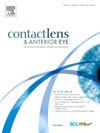Improved control efficacy of a novel aspherical orthokeratology lens compared with the traditional three-zone spherical lens in a single-blind randomized clinical trial
IF 3.7
3区 医学
Q1 OPHTHALMOLOGY
引用次数: 0
Abstract
Purpose
Orthokeratology lenses slow myopia progression by over 50% on average. Efficacy and optical outcomes of aspherical and spherical orthokeratology lens designs in controlling myopia progression are compared, focusing on axial length (AL), choroidal thickness (CHT), and relative peripheral refractive errors.
Methods
A multicenter, single-blind, randomized controlled trial was conducted in Sichuan, China (2022–2023), with 30 participants aged 8–13 (mean age 10.8 ± 1.8 years; 70 % male). Inclusion criteria embraced refractive errors between −0.75 and −6.00 D. Each eye was randomly assigned to a spherical or aspherical lens. Measurements included AL and central corneal thickness and retinal defocus at baseline and 3, 6, 9, and 12 months.
Results
No baseline differences were observed between groups (P > 0.05). Throughout the 12 months, axial length (AL) increases were reported as 0.04 ± 0.18 mm and 0.25 ± 0.23 mm in the aspherical and spherical groups, respectively (P < 0.001). The aspherical lens produced greater corneal reshaping (nasal: 65.67 μm vs. 61.23 μm, P = 0.008; temporal: 68.03 μm vs. 61.07 μm, P = 0.002) and less hyperopic defocus (RDV30-45 and RDV45-53; P < 0.001). The change in AL correlated positively with the change in RDV. No other significant between-group differences in CHT changes were observed (P = 0.203).
Conclusion
Aspherical orthokeratology lenses show superior control of axial length compared to spherical lens designs due to increased sagittal height and peripheral myopic defocus within 15°-45° of retinal eccentricity.
一项单盲随机临床试验中,新型非球面角膜塑形镜与传统三区球面角膜塑形镜相比控制效果的提高。
目的:角膜塑形镜平均减缓近视进展50%以上。比较了非球面和球形角膜塑形镜设计在控制近视进展方面的效果和光学结果,重点是轴长(AL)、脉络膜厚度(CHT)和相对周围屈光不正。方法:在中国四川进行一项多中心、单盲、随机对照试验(2022-2023),参与者30名,年龄8-13岁(平均年龄10.8±1.8岁;男性占70%)。纳入标准包括屈光不正在-0.75到-6.00 d之间。每只眼睛随机分配到球形或非球面晶状体。测量包括基线、3、6、9和12个月时的AL和中央角膜厚度以及视网膜离焦。结果:各组间无基线差异(P < 0.05)。在12个月内,非球面组和球形组的轴向长度(AL)分别增加0.04±0.18 mm和0.25±0.23 mm (P < 0.001)。非晶状体产生更大的角膜重塑(鼻腔:65.67 μm vs. 61.23 μm, P = 0.008;时间:68.03 μm vs. 61.07 μm, P = 0.002),远视离焦较少(RDV30-45和RDV45-53;P < 0.001)。AL的变化与RDV的变化呈正相关。各组间CHT变化差异无统计学意义(P = 0.203)。结论:与球形镜片相比,非球面角膜塑形镜由于矢状高度增加和周围性近视离焦在视网膜偏心15°-45°范围内,具有更好的轴向长度控制。
本文章由计算机程序翻译,如有差异,请以英文原文为准。
求助全文
约1分钟内获得全文
求助全文
来源期刊

Contact Lens & Anterior Eye
OPHTHALMOLOGY-
CiteScore
7.60
自引率
18.80%
发文量
198
审稿时长
55 days
期刊介绍:
Contact Lens & Anterior Eye is a research-based journal covering all aspects of contact lens theory and practice, including original articles on invention and innovations, as well as the regular features of: Case Reports; Literary Reviews; Editorials; Instrumentation and Techniques and Dates of Professional Meetings.
 求助内容:
求助内容: 应助结果提醒方式:
应助结果提醒方式:


